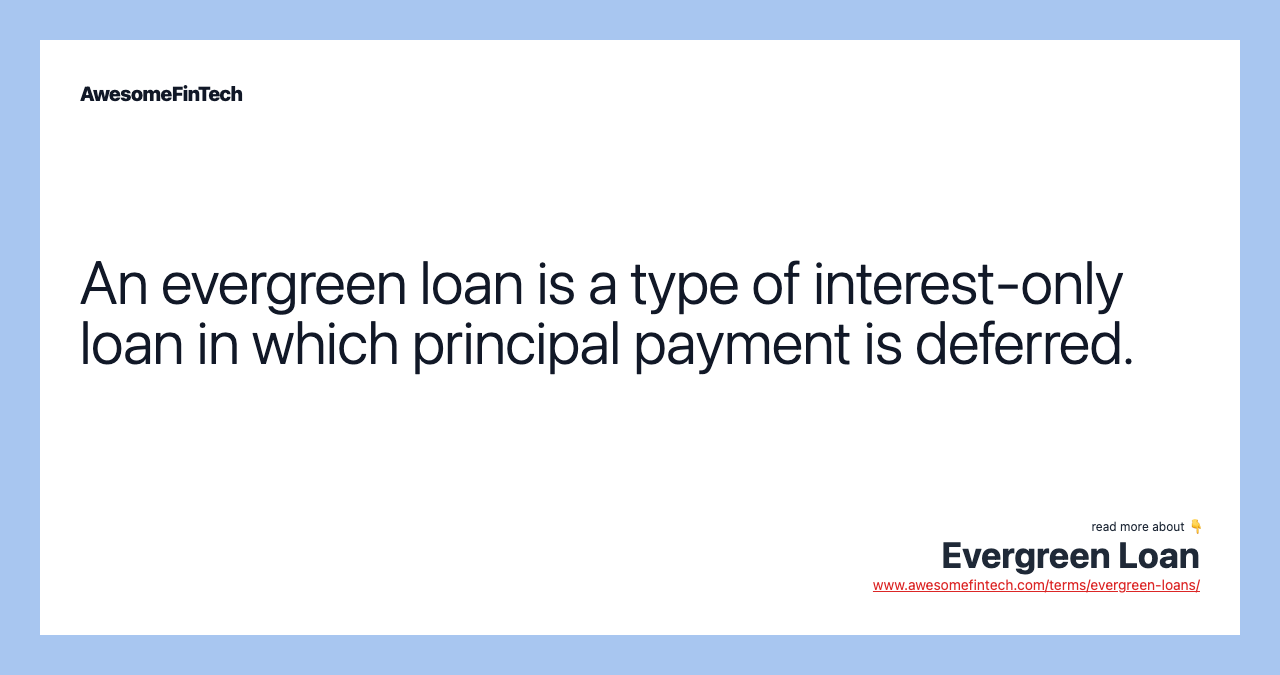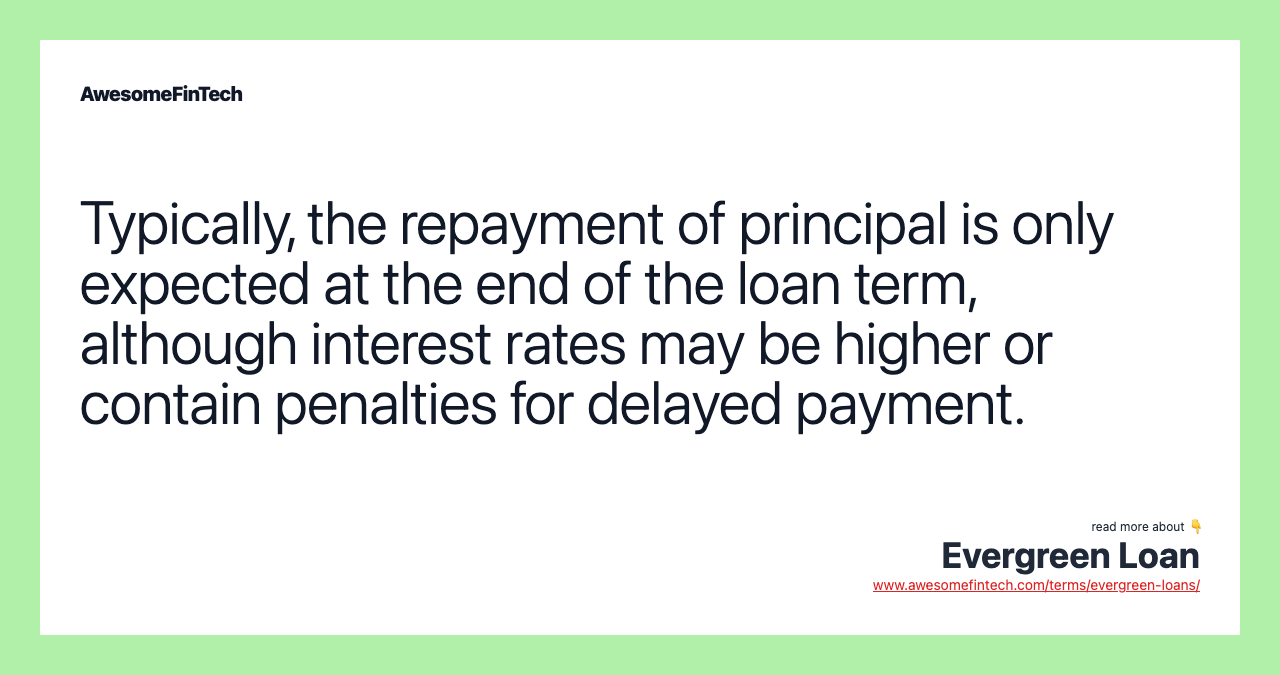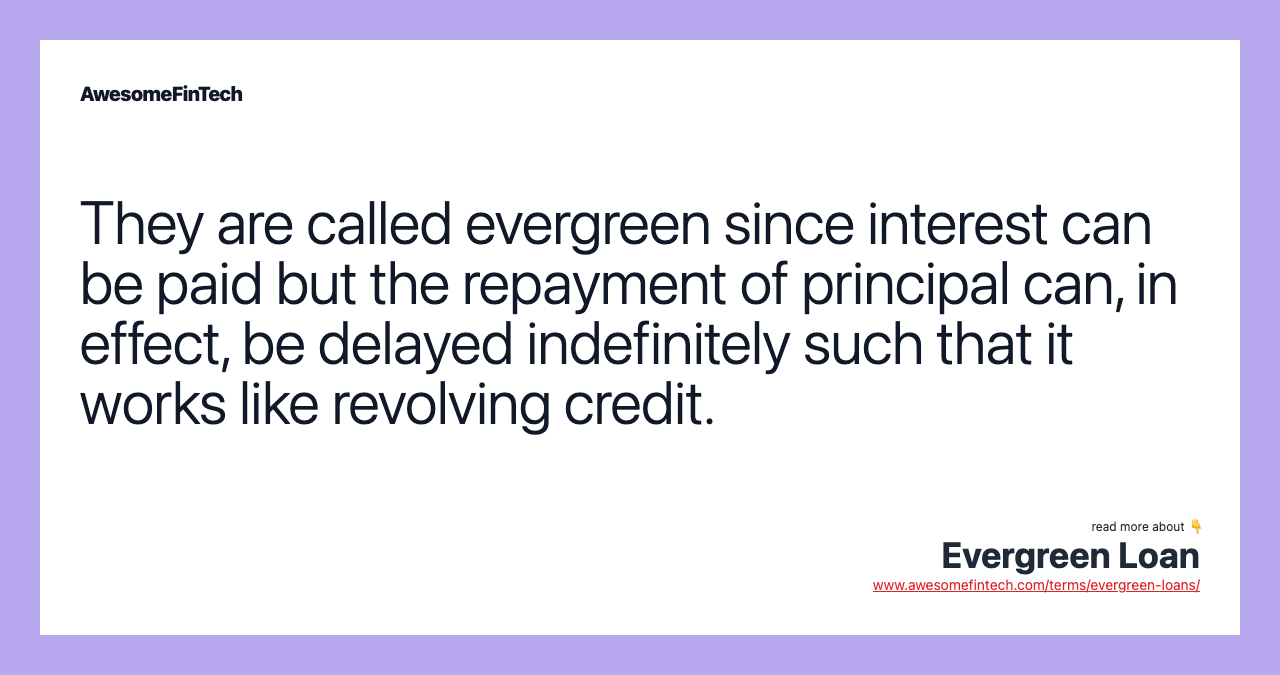Evergreen Loan
An evergreen loan is a loan that does not require the repayment of principal during the life of the loan, or during a specified period of time. The overdraft line of credit can be used to protect the borrower from overdrafts, with funds immediately withdrawn from the line-of-credit account if insufficient funds are available in a customer’s checking account. Credit cards and checking account overdraft lines of credit are two of the most common evergreen loan products offered by credit issuers. Similar to a credit card account, borrowers will receive monthly statements in regard to their line-of-credit account. Credit card borrowers must complete a credit application, which is based on their credit score and credit profile.

What Is an Evergreen Loan?
An evergreen loan is a loan that does not require the repayment of principal during the life of the loan, or during a specified period of time. In an evergreen loan, the borrower is required to make only interest payments during the life of the loan. Evergreen loans are usually in the form of a line of credit that is continuously paid down, leaving the borrower with available funds for credit purchases. Evergreen loans may also be known as “standing” or “revolving” loans.



How an Evergreen Loan Works
Evergreen loans can take many forms and are offered through varying types of banking products. Credit cards and checking account overdraft lines of credit are two of the most common evergreen loan products offered by credit issuers. Evergreen loans are a handy type of credit because they revolve, meaning users do not need to reapply for a new loan every time they need money. They can be used by both consumers and businesses.
Non-revolving credit differs in that it issues a principal amount to a borrower when a loan is approved. It then requires that a borrower pay a scheduled amount over the duration of the loan until the loan is paid off. Once the loan is repaid, the borrower’s account is closed, and the lending relationship ends.
Evergreen loans provide borrowers with monetary flexibility but require the ability to regularly make minimum monthly payments.
How Businesses and Consumers Use Evergreen Loans
In the credit market, borrowers can choose from both revolving and non-revolving credit products when seeking to borrow funds. Revolving credit offers the advantage of an open line of credit that borrowers can draw from over their entire life, as long as they remain in good standing with the issuer. Revolving credit may also offer the advantage of lower monthly payments than non-revolving credit. With revolving credit, issuers provide borrowers with a monthly statement and minimum monthly payment that they must make to keep their account current.
Examples of Evergreen Loans
Credit cards are one of the most common types of evergreen loans. Credit cards may be issued by a bank and added to a customer’s account in addition to a checking account. They may also be issued by other companies with which the consumer does not have additional account relationships.
Credit card borrowers must complete a credit application, which is based on their credit score and credit profile. Information is obtained from a credit bureau as a hard inquiry and used by underwriters for making a credit decision. If approved, a borrower is granted a maximum borrowing limit and issued a credit payment card for making transactions. The borrower can make purchases with credit at any time up to the available limit. The borrower pays down the card balance each month by making at least the minimum monthly payment, which includes principal and interest. Making a monthly payment increases the available funds the borrower can use.
An overdraft line of credit is another common evergreen loan product utilized by borrowers and is associated with a borrower’s checking account. For approval, borrowers must complete a credit application that considers their credit profile. Typically, retail borrowers approved for overdraft credit accounts receive a maximum borrowing limit of approximately $1,000. The overdraft line of credit can be used to protect the borrower from overdrafts, with funds immediately withdrawn from the line-of-credit account if insufficient funds are available in a customer’s checking account. Borrowers may also take funds from the account through cash advances to their checking account for other purchases as well.
Similar to a credit card account, borrowers will receive monthly statements in regard to their line-of-credit account. The statements provide details on the outstanding balance and the minimum monthly payments. Borrowers must make the minimum monthly payment to keep the account in good standing.
Related terms:
Average Outstanding Balance
An average outstanding balance is the unpaid, interest-bearing balance of a loan or loan portfolio averaged over a period of time, usually one month. read more
Checking Account
A checking account is a deposit account held at a financial institution that allows deposits and withdrawals. Checking accounts are very liquid and can be accessed using checks, automated teller machines, and electronic debits, among other methods. read more
Credit Card Balance
A credit card balance is the total amount of money that you owe to your credit card company. The balance changes based on when and how the card is used. read more
Credit Card Debt
Credit card debt is a type of unsecured liability that is incurred through revolving credit card loans. It greatly affects your credit score. read more
Credit Utilization Ratio
A credit utilization ratio is the percentage of a borrower’s total credit currently being used. Learn how to improve your credit utilization ratio. read more
Credit Score: , Factors, & Improving It
A credit score is a number between 300–850 that depicts a consumer's creditworthiness. The higher the score, the better a borrower looks to potential lenders. read more
Credit Bureau
A credit bureau is an agency that collects and researches individual credit information and sells it to creditors for a fee. read more
Line of Credit (LOC) , Types, & Examples
A line of credit (LOC) is an arrangement between a bank and a customer that establishes a preset borrowing limit that can be drawn on repeatedly. read more
Minimum Monthly Payment
The minimum monthly payment is the lowest amount a customer can pay on a revolving credit account to remain in good standing with the credit card company. read more
Non-Sufficient Funds (NSF)
An NSF fee or non-sufficient funds fee occurs when a bank account does not have enough money to cover a payment. Read about NSF fees and how to avoid them. read more